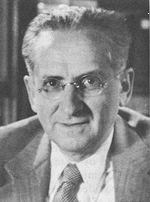| Profile | Major Works | Resources |
Jacob Marschak, 1898-1977.

As a Russian-raised, German-taught Jewish radical, Jacob Marschak lived a life of travails.
Born in Kiev, Jacob Marschak was in his youth successively a Menshevik activist, prisoner of the
Tsar, Ukranian official, minister of labor in the
short-lived Cossack-Menshevik Republic of Terek in the north Caucasus - before emigrating
to Berlin in 1919. At Berlin and later at Heidelberg (where he received his
Ph.D. in 1922), Jacob Marschak came under the influence
of the Marxian economists Bortkiewicz
and Lederer. After a period as an economics
reportor, Marschak moved on to the Kiel Institute under Adolph Lowe
in 1926.
In 1930, Marschak returned to Heidelberg as a lecturer..
Marschak's early work was certainly in the spirit of his masters: an anti-Austrian 1923 tract got him involved in the Socialist Calculation debate - arguing that the monopolistic tendencies of capitalism made the socialist system inevitably more efficient at pricing. This was an early signal of a topic which would emerge time and time again: the economics of organization. His work on the "New Middle Class" - first a paper in 1926, then a book with Lederer in 1937 - which presented his thesis about the fall of white-collar workers from the bourgeois class (where they remained socially) to the working class (where they now were economically), became classics of interwar Marxian theory.
A master of the structural growth economics of the Kiel strain, Marschak was impressed by the need for quantification of economics. His 1931 paper on the elasticity of demand was a landmark in econometric analysis.
Dismissed from his position a Heidelberg by the Nazis, Jacob Marschak joined the stream of emigré scholars out of Germany. In 1933, Marschak moved to England, where a makeshift position as lecturer at All Souls' College, Oxford was arranged for him. With his quantitative skills and a grant from the Rockefeller foundation, Marschak established the Oxford Institute of Statistics in 1935, and served as its first director until 1939. With the outbreak of the war, Marschak followed Lederer and Lowe to the New School for Social Research in 1940. While there, Marschak was instrumental in gathering together a mathematical and econometric seminar which brought together much of the fledgling quantitative community in the New York City area.
In 1943, Jacob Marschak was appointed head of the Cowles Commission during the crucial move from Colorado Springs to the University of Chicago (Marschak simultaneously took an appointment at the economics department). Maschak held this position until 1948. As a result, Jacob Marschak can be given credit for getting the ball rolling for the development of Neo-Walrasian economics and econometrics in the post-war era. His work with Andrews (1944) brought him to the fore of the econometric world, a theoretical explanation for employing the statistical techniques of causal analysis in the spirit of Haavelmo - what was to become the methodological groundwork of the Cowles approach.
Marschak's contributions to economic theory in this phase were dominated by his interest in the concept of uncertainty. Already in his classic 1938 papers (one with Helen Makower) on monetary theory, Marschak set down the basic ideas for portfolio theory, in which risk was acknowledged to play a role. His encounter with the work of John von Nemann and Oskar Morgenstern (1944) led him to write his famous 1950 exposition of the axiomatization of choice under uncertainty, when he introduced the infamous "independence axiom". Maurice Allais's critique of the axiom led him to his famous "normative" defense of expected utility theory (1951).
It was specifically in the theory of information, the theory of "teams" and decentralized organizations where Marschak was to make his name (1954, 1968, 1971, 1972). He is renowned for having developed the theory of stochastic design as a way of statistically measuring demand. It was Marschak who helped introduce modern information theory into economics via Shannon's formalization of information via the mathematical theory of communication.
Marschak's influence on colleagues and students along his itinerary was significant. Helen Makower at Oxford, Franco Modigliani at the New School, Leonid Hurwicz and Don Patinkin at Chicago, and Kenneth J. Arrow, Roy Radner, Lawrence Klein, Trygve Haavelmo and others at Cowles Commission, were to carry on his legacy more fully.
Marschak passed on the reins of research director of Cowles Commission to Tjalling Koopmans in 1948. Nonetheless, Marschak followed the move of Cowles from Chicago to Yale in 1955. Marschak subsequently crossed the country in 1960, to take a position at UCLA, which he held until his death.
|
Major works of Jacob Marschak
|
HET
|
|
Resources on Jacob Marschak
|
All rights reserved, Gonçalo L. Fonseca
